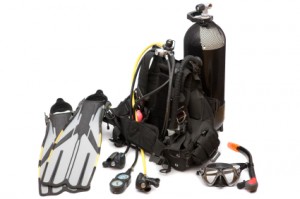BCs, Tanks, Regulators and Instruments
The equipment that is used in scuba diving can be complex to understand, use and setup,  but it is all of help in making the whole scuba diving experience seamless and allows you to get the most out of your dive. After all, you -want to get underwater to swim around, learn about life under the sea and be in harmony with the nature that’s there. Seeing what’s been left under the sea, what creatures inhabit the sea or coral reefs you are visiting are all the experiences that you are seeking most likely.
but it is all of help in making the whole scuba diving experience seamless and allows you to get the most out of your dive. After all, you -want to get underwater to swim around, learn about life under the sea and be in harmony with the nature that’s there. Seeing what’s been left under the sea, what creatures inhabit the sea or coral reefs you are visiting are all the experiences that you are seeking most likely.
Without the proper setup and use of the equipment we’re discussing here that experience could be cut short or not be the fullest experience possible.
BCs are Buoyancy Compensators and help you control your depth by their inflation and deflation depending on how buoyant you need to be.
The amount of air in your tank and the depth at which you’re diving determines how your buoyancy changes. So that you don’t have to constantly deal with how deep you are under water and whether you are rising or going deeper, you need a device to help you manage your buoyancy. This is a mandatory safety device for scuba divers.
There are various types of BC devices, having evolved over time to serve many purposes. They have become more complex as they evolved into multi-functional devices. Certain of them are more popular for different types of divers. Get some advice and help selecting the one that will be right for your personal diving needs.
Tanks or Scuba Cylinders allow you to breathe underwater. They contain the air that you need to go scuba diving. Many people know that SCUBA is an acronym that stands for “Self-Contained Underwater Breathing Apparatus.” So the tank that contains compressed air is important to how you breathe under water and determines how long you can stay under, also controlling how deep you can go. These tanks must be fail-safe, as if they fail when you’re on a dive; your options are limited to get back up to the top. You will need a buddy most likely to share their air with you on the ascent or maybe if you’ve taken a spare tank down you can switch to it. The ascent needs to be controlled so that getting to the surface too fast without the ability to get the nitrogen out of your system doesn’t cause other health issues because of the bends.
A regulator is required to breathe the air from the tank. This is the piece of gear that controls and regulates how air flows to you, through your mouthpiece and also to your other hoses, attachments like a pressure gauge, a dive computer and a secondary source of air.
The function of the regulator is to take the air that’s under very high pressure in the tank and brings it to the pressure of the water around you at any given point in time. They are aware of a divers breathing, opening and closing (also called a demand valve) as the diver breathes in or out.
Various diving instruments are taken down with the scuba diver, including items like: submersible pressure gauge (SPG), depth gauge, timing device, and optional ones such as a compass and thermometer.
